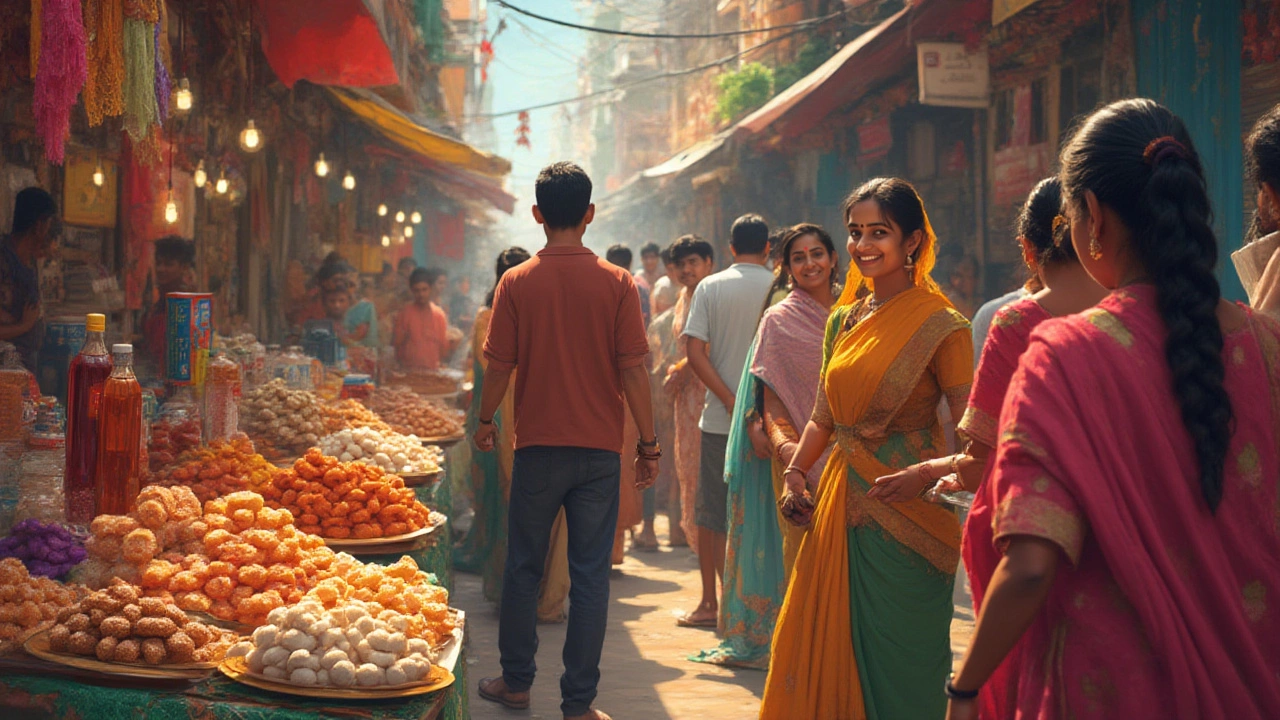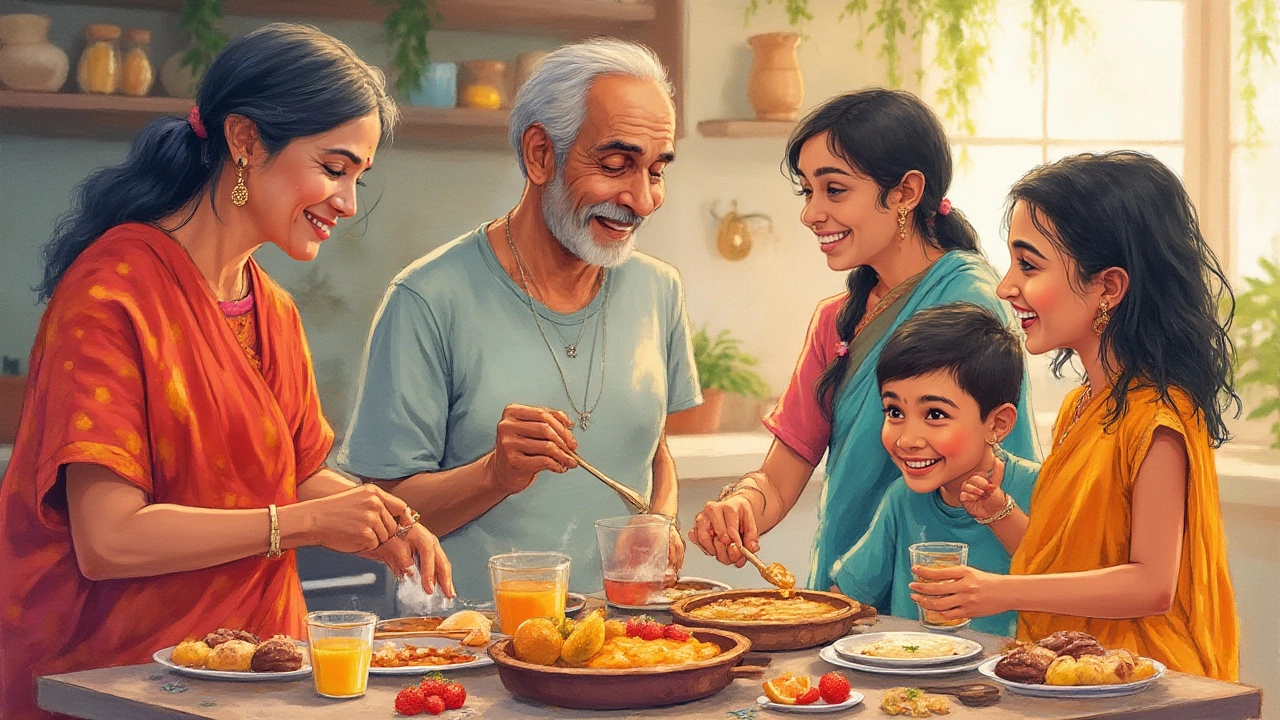Which Ethnic Group Consumes the Most Sugar? Surprising Facts Revealed
 Jul, 29 2025
Jul, 29 2025
You’d probably never guess that your neighbor’s grocery cart—or your own—could say a lot about global nutrition trends. Sugar might seem simple: white crystals, sweet taste, sprinkled on breakfast cereal. But when you look past the kitchen counter, sugar tells the story of whole communities, long histories, and even disparities in health. Some groups reach for sugary drinks and processed snacks more than others—and it’s not always by choice. Family recipes, advertising, and neighborhood grocery options can tip the scales, long before doctors ever start talking about diabetes.
What Do Sugar Consumption Numbers Actually Say?
If you think everyone eats sugar the same way, a peek at the data tells a different story. According to reports from the World Health Organization and the US Centers for Disease Control and Prevention, the average American consumes well over 17 teaspoons of added sugar daily. But that’s just an average—the details get fascinating once you break things down by race and ethnicity.
For instance, in the United States, Black Americans and Hispanic Americans often report higher average intakes of added sugar than White or Asian American communities. A CDC nutrition survey known as NHANES (National Health and Nutrition Examination Survey) from before the pandemic showed Black children consuming about 18% of their daily calories from added sugars—two or three percent higher than White or Hispanic children. Asian American kids, on the other hand, averaged lowest—hovering just below 14%. When you scale this to adult populations, similar differences appear, though the precise percentage points shift with age, income, and region.
Solid facts paint a clear picture: in Europe, too, countries with higher immigrant populations (especially from the Caribbean or parts of Africa) show elevated sugary drink consumption. In the UK, for example, studies flagged South Asian and Black Caribbean communities as drinking more sugar-sweetened beverages than their White British neighbors. Ironically, many of these groups once had relatively low traditional sugar intakes back in their home countries, but acculturation—moving and adopting new food habits—can change everything quickly.
What’s pushing these numbers? Marketing and food deserts play a starring role. If you live in an area where healthy options are rare, you’ll find store shelves stacked with sodas and snack cakes, not apples and brown rice. There’s more too—poverty and stress levels tip people toward sweet comfort foods, especially when brands target lower-income neighborhoods with aggressive junk food ads. All these forces combine, turning sugar from a treat into a dangerous staple.
But back to the big question—sugar consumption by race isn’t about genetics or biology. It’s about where you live, what you can buy, and the cultural rituals around food that shape what lands on your plate every week. It sounds simple, but the story is tangled, layered, and anything but fair.
Why Do Some Groups Eat More Sugar Than Others?
You might be thinking, “Is it just taste, or is there more going on?” It turns out the answer is as much about history and environment as about craving sweets. Many foods loaded with added sugar—not just candies, but breakfast cereals, energy drinks, sauces, and even ‘healthy’ yogurt—end up in the shopping baskets of families whose wallets are stretched thin. That’s not a coincidence, but a reflection of what food companies think people will buy—and where they choose to deliver their darkest deals.
A closer look at neighborhoods tells a revealing tale. In predominantly Black, Hispanic, or lower-income areas, stores are statistically less likely to offer fresh, affordable fruit or whole grains. Picture towering walls of soda and boxed pastries—cheap, filling, but loaded with added sugars. If you add up these small choices over decades, you see why diabetes and obesity rates can skyrocket along racial lines.
Cultural tradition plays its part too. Ask anyone who’s ever had ladoos at Diwali or Tres Leches cake at a family quinceañera—celebration often means extra sugar. But let’s not blame tradition: in many African, Asian, and Latin American cultures, classic dishes are not as sweet as those in Western supermarkets. It’s when traditional diets meet modern food systems—where sugar is cheap, processed, and disguised under dozens of names—that consumption rises sharply.
I’ve seen this first-hand at family gatherings with Priya. The table groans under the weight of gulab jamun and jalebi, but the real sugar bomb is waiting in the cola bottles and packaged biscuits that kids nibble all evening. It’s easy to forget how much sugar sneaks into the mix until you read a label—and realize a single can of soda has more sugar than an entire meal cooked from scratch.
Psychology matters here too. Stress, insecurity, and sleepless nights drive people toward comfort foods, often packed with sugar. Social norms—even simple peer pressure—keep people coming back for sugary coffee or post-dinner dessert, no matter their intentions. Brands know this, and their ads promise happiness, friendship, and energy with every sip or bite. The cycle is hard to break.
The science says it’s not just about willpower. Glucose and fructose trigger feel-good chemicals in the brain, offering quick highs that mimic mild addiction. So, in communities where life throws more challenges, the short-term comfort of sweet foods is hard to resist. Combine all this, and you have a perfect storm: history, economics, culture, and biology, all swirling around a spoonful of sugar.

The Health Effects: More Sugar, More Risk?
Doctors and dietitians don’t mince words—high sugar intake is a fast track to health problems. But the real kicker is how those risks stack up unfairly. In the US, Black and Hispanic adults are twice as likely as White adults to be diagnosed with Type 2 diabetes. Heart disease, cavities, fatty liver, and even some cancers latch onto high sugar diets and refuse to let go.
It’s not just the sugar itself, but what rides along with it. Sugary drinks sabotage the body’s control of insulin, leading to higher blood pressures, waistlines, and risk factors for everything from blindness to kidney failure. If you look at hospital charts, the odds of serious long-term illness often run parallel to zones with the highest sugar sales. A 2022 study from the American Heart Association pointed out that children from non-White backgrounds in the US were almost 1.5 times more likely to be exposed to added sugar in daily food—think birthday snacks, processed muffins, or even supposedly healthy juice boxes.
Why does it matter so much? Early, repeated sugar spikes train the pancreas (and the rest of the body) to expect insulin swings—leading to burnout and metabolic confusion. Over time, this turns into prediabetes, then full-blown Type 2 diabetes, which is much harder to manage down the road. Crowded cities with little green space, limited recreational areas, or inaccessible healthy groceries set up generations for a lifetime of battling sugar’s hidden effects.
But here’s a shocker—lots of people still don’t realize how much sugar they’re eating, thanks to hidden sugars. Ketchup, salad dressings, pasta sauces, even chilled soups—most have added sugars lurking under names like maltodextrin, sucrose, or high fructose corn syrup. If you compare the lunchboxes of White kids and their Black or Latino classmates in US schools, studies show the latter are more likely to have sugar-packed breakfast bars or energy drinks, often influenced by cost and what’s available nearby.
Some good news? Small changes matter, and when communities get better access to fruits, whole grains, and trustworthy health information (not just label warnings), things start to shift. Cities with aggressive limits on sugary drinks—like Philadelphia—saw per capita sugar consumption drop, along with childhood obesity numbers. Nothing changes overnight, but every bottle left on the shelf makes a difference.
Tips for Cutting Down—And Why It Matters for Everyone
No one wants to live on broccoli alone, and cutting sugar isn’t about zero-joy diets. It’s about making smarter swaps and knowing when the sweet stuff is worth it. For families watching their health or looking at their heritage—think back to what your grandparents actually ate. Homemade roti, real fruit, steamed veggies—these don’t hide sugar the way energy drinks and supermarket pies do.
- Read labels carefully: Don’t be fooled by “natural” or “whole grain” promises—hidden sugars are everywhere. If the first three ingredients end in “-ose,” it’s not a good bet for your blood sugar.
- Flip your breakfast: Instead of sugary cereal or white bread with jam, try oatmeal with fresh banana, or dosa with coconut chutney. The extra fiber slows sugar spikes, so you feel full longer.
- Drink smart: Swap fruit juice or soda for water with a splash of lemon, or even lightly flavored seltzer. Kids resist at first, but taste buds change fast with new habits.
- Snack with crunch, not syrup: Keep karela chips, roasted chana, or cut veggies handy—easy, crunchy, and naturally low in sugar.
- Watch the social cues: Sometimes sweets are about sharing love or respect, not empty calories. Choose smaller portions, or make a homemade version with half the sugar—no one ever notices, trust me.
- Tackle it as a family: Talk with your kids and elders about why cutting sugar matters. Celebrate wins (“no soda for a week!”), and keep sugary treats for special events instead of daily rewards.
Food choices are wrapped up in so many things—history, identity, comfort, and resilience. But with sugar, a little awareness goes a long way. If you’re reading this thinking about your own kitchen, don’t stress about every bite. Start with one swap a week. And share what you learn—sometimes the quietest shifts at your dinner table are what ripple out to friends, neighbors, and communities. The story of sugar isn’t written in stone. And every new recipe or shopping choice is a step toward rewriting it—for yourself, or maybe even for your whole block.